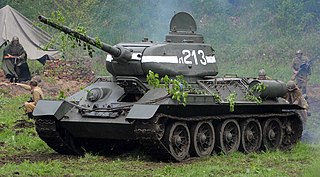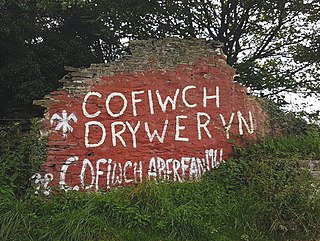
Bermondsey is a district in southeast London, part of the London Borough of Southwark, England, 2.5 miles (4.0 km) southeast of Charing Cross. To the west of Bermondsey lies Southwark, to the east Rotherhithe and Deptford, to the south Walworth and Peckham, and to the north is Wapping across the River Thames. It lies within the historic county boundaries of Surrey. During the Industrial Revolution Bermondsey became a centre for manufacturing, particularly in relation to tanning. More recently it has experienced regeneration including warehouse conversions to flats and the provision of new transport links.

The T-34 is a Soviet medium tank from World War II. When introduced, its 76.2 mm (3 in) tank gun was more powerful than its contemporaries, and its 60-degree sloped armour provided good protection against anti-tank weapons. The T-34 had a profound effect on the conflict on the Eastern Front, and had a long-lasting impact on tank design. The tank was praised by multiple German generals when encountered during Operation Barbarossa, although its armour and armament were surpassed later in the war. Though, its main strength was its cost and production time, meaning that German panzer forces would often fight against Soviet tank forces several times their size. The T-34 is also a critical part of the mechanized divisions that form the backbone of the Deep Battle Strategy.

The Panzerkampfwagen IV, commonly known as the Panzer IV, is a German medium tank developed in the late 1930s and used extensively during the Second World War. Its ordnance inventory designation was Sd.Kfz. 161.

Banksy is a pseudonymous England-based street artist, political activist and film director whose real name and identity remain unconfirmed and the subject of speculation. Active since the 1990s, his satirical street art and subversive epigrams combine dark humour with graffiti executed in a distinctive stenciling technique. His works of political and social commentary have appeared on streets, walls and bridges throughout the world. Banksy's work grew out of the Bristol underground scene, which involved collaborations between artists and musicians. Banksy says that he was inspired by 3D, a graffiti artist and founding member of the musical group Massive Attack.

The Casa Rosada, literally the Pink House, is the president of the Argentine Republic's official workplace, located in Buenos Aires. The palatial mansion is known officially as Casa de Gobierno. Normally, the president lives at the Quinta de Olivos, the president of Argentina's official residence, located in Olivos, Greater Buenos Aires. The characteristic color of the Casa Rosada is baby pink, and it is considered one of the most emblematic buildings in Buenos Aires. The building also houses a museum, which contains objects relating to former presidents of Argentina. It has been declared a National Historic Monument of Argentina.

The Archdiocese of Southwark is a Latin Church archdiocese of the Catholic Church in England. It is led by the Archbishop of Southwark. The archdiocese is part of the Metropolitan Province of Southwark, which covers the South of England. The Southwark archdiocese also makes up part of the Catholic Association Pilgrimage.

The T-44 was a medium tank first developed and produced near the end of World War II by the Soviet Union. It was the successor to the T-34, offering an improved ride and cross-country performance, along with much greater armor. Designed to be equipped with an 85 mm main gun, by the time it was fully tested the T-34 had also moved to this weapon. Both tanks offered similar performance, so introducing the T-44 was not considered as important as increasing T-34 production. Fewer than 2,000 T-44s were built, compared to about 58,000 T-34s. Although the T-44 was available by the end of the war, it was not used in any battle. It was 1 ton lighter than the T-34-85 and slightly faster. The T-44 was heavily influential on the design of the T-54/55 main battle tank, most notably the removal of side sloping, thick frontal armor, and a low profile. Also notable was the T-44-100, a 100mm D-10T-armed prototype, which would be the same 100mm gun mounted on the T-54/55, bar some minor changes.

The T-60 scout tank was a light tank produced by the Soviet Union from 1941 to 1942. During this period, 6,292 units were built. The tank was designed to replace the obsolete T-38 amphibious scout tank and saw action during World War II.

Military camouflage is the use of camouflage by an armed force to protect personnel and equipment from observation by enemy forces. In practice, this means applying colour and materials to military equipment of all kinds, including vehicles, ships, aircraft, gun positions and battledress, either to conceal it from observation (crypsis), or to make it appear as something else (mimicry). The French slang word camouflage came into common English usage during World War I when the concept of visual deception developed into an essential part of modern military tactics. In that war, long-range artillery and observation from the air combined to expand the field of fire, and camouflage was widely used to decrease the danger of being targeted or to enable surprise. As such, military camouflage is a form of military deception in addition to cultural functions such as political identification.

The Monument to Soviet Tank Crews was a World War II memorial located in Prague. It is also known as the Pink Tank because it was controversially painted pink in 1991, first by installation artist David Černý and a second time by members of parliament in protest at his arrest.

The Pink Lady is the nickname of a B-17G Flying Fortress bomber, serial number 44-8846, which flew several missions for the United States Army Air Forces (USAAF) over Nazi Germany near the end of World War II. The plane is now on static display in Cerny, Essonne, France.

The Fiat 2000 was an Italian heavy tank designed and produced by Fiat during World War I. Only two were built as it never entered serial production. It was one of the largest designs of its time.

St Mary Magdalen Bermondsey is an Anglican church dedicated to St Mary Magdalen in Bermondsey in the London Borough of Southwark. The majority of the present building is late 17th century and is Grade II* listed.

Alcatraz water tower is on Alcatraz Island in the San Francisco Bay, off the coast of San Francisco, California. It is located on the northwestern side of the island, near Tower No. 3, beyond the Morgue and Recreation Yard. The water tank is situated on six cross-braced steel legs submerged in concrete foundations.

The use of markings on British military vehicles expanded and became more sophisticated following the mass production and mechanization of armies in World War II.
Military markings on United States army vehicles were upgraded in August 1942 when specific new rules were adopted. New marks, from the national identification symbol downwards were ordered to be put on "all motor vehicles assigned to tactical units".

Cofiwch Dryweryn is a graffitied stone wall near Llanrhystud, Ceredigion, Wales. Author and journalist Meic Stephens originally painted the words onto the wall of a ruined cottage in the early 1960s following the decision by the Liverpool City Council to commence the Tryweryn flooding, including the community of Capel Celyn to create the Llyn Celyn reservoir. Due to its prominent location, stark message, and history of repeated vandalism, the wall has become an unofficial landmark of mid Wales. The phrase "Cofiwch Dryweryn" has itself become a prominent political slogan for Welsh nationalism, appearing on T-shirts and banners, and as replica murals.

Dulwich Community Hospital was a hospital located in Dulwich, in South London.































